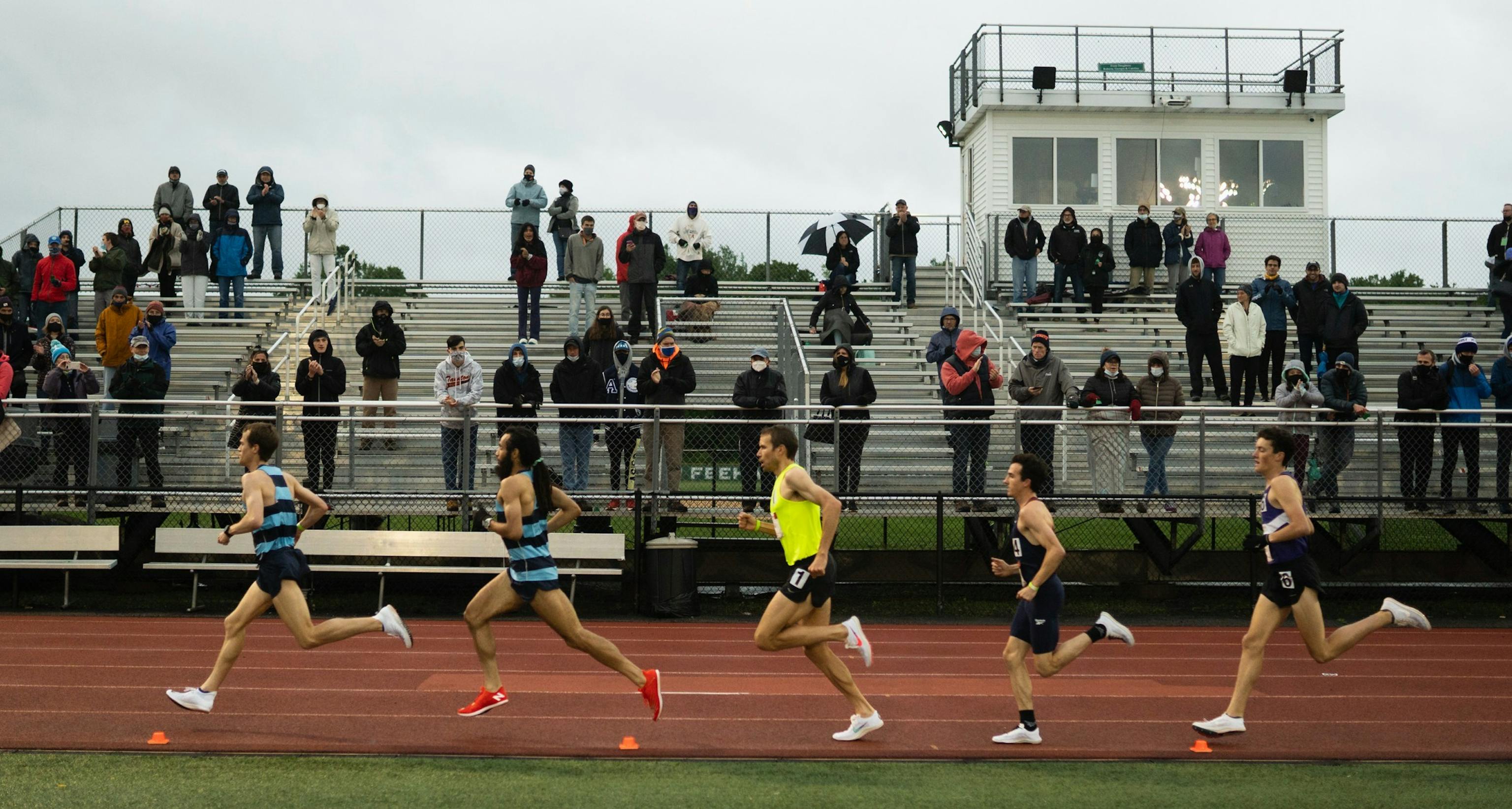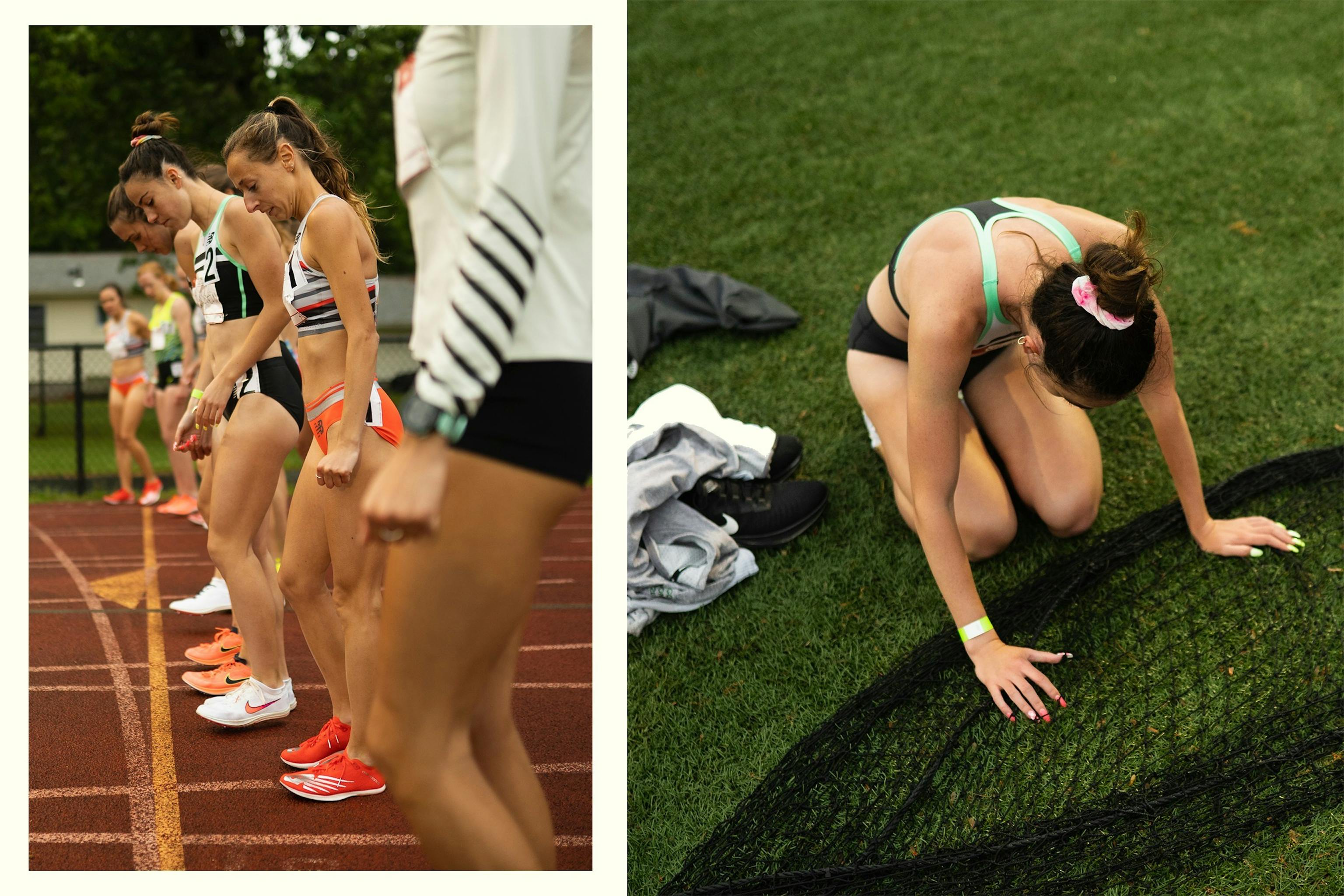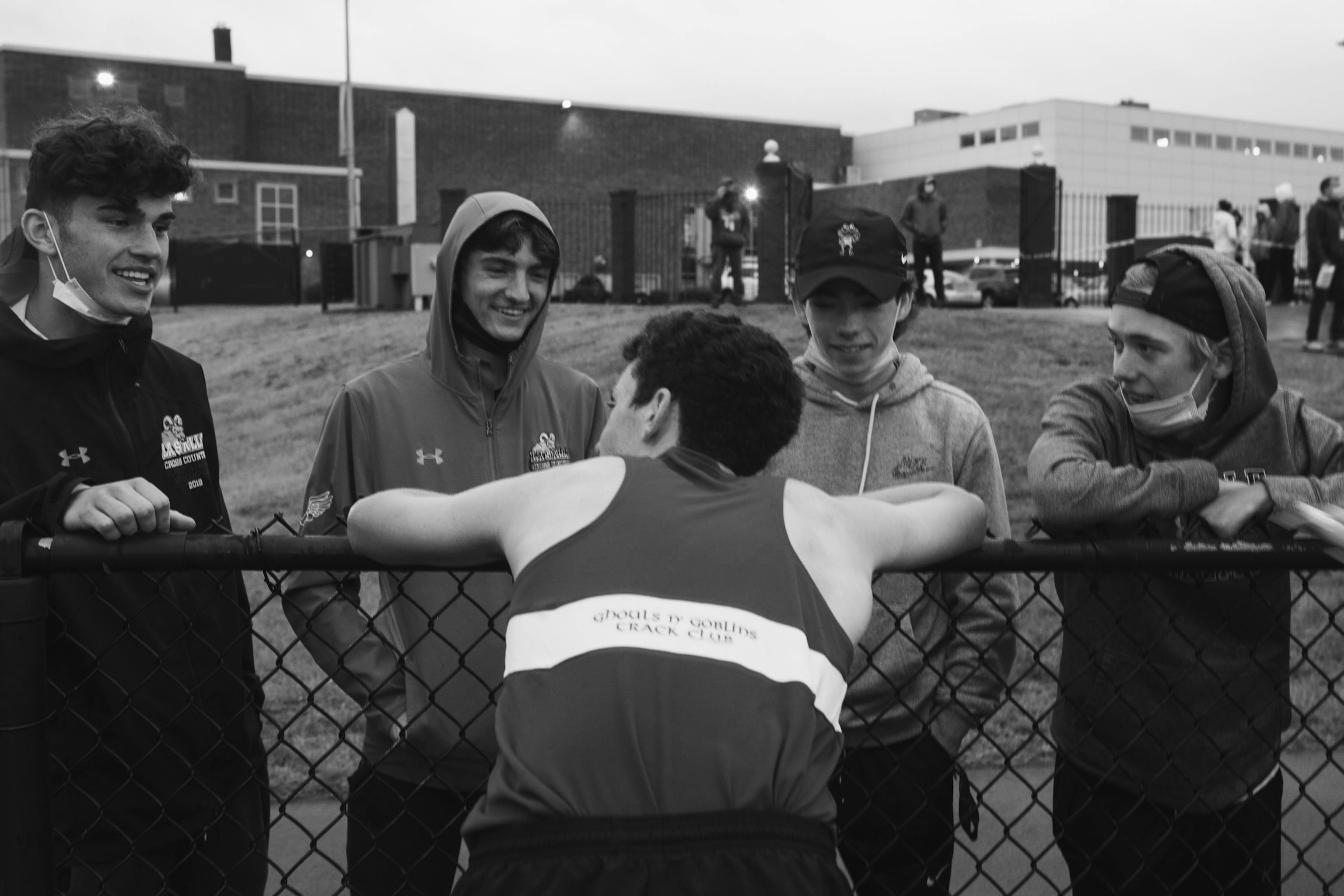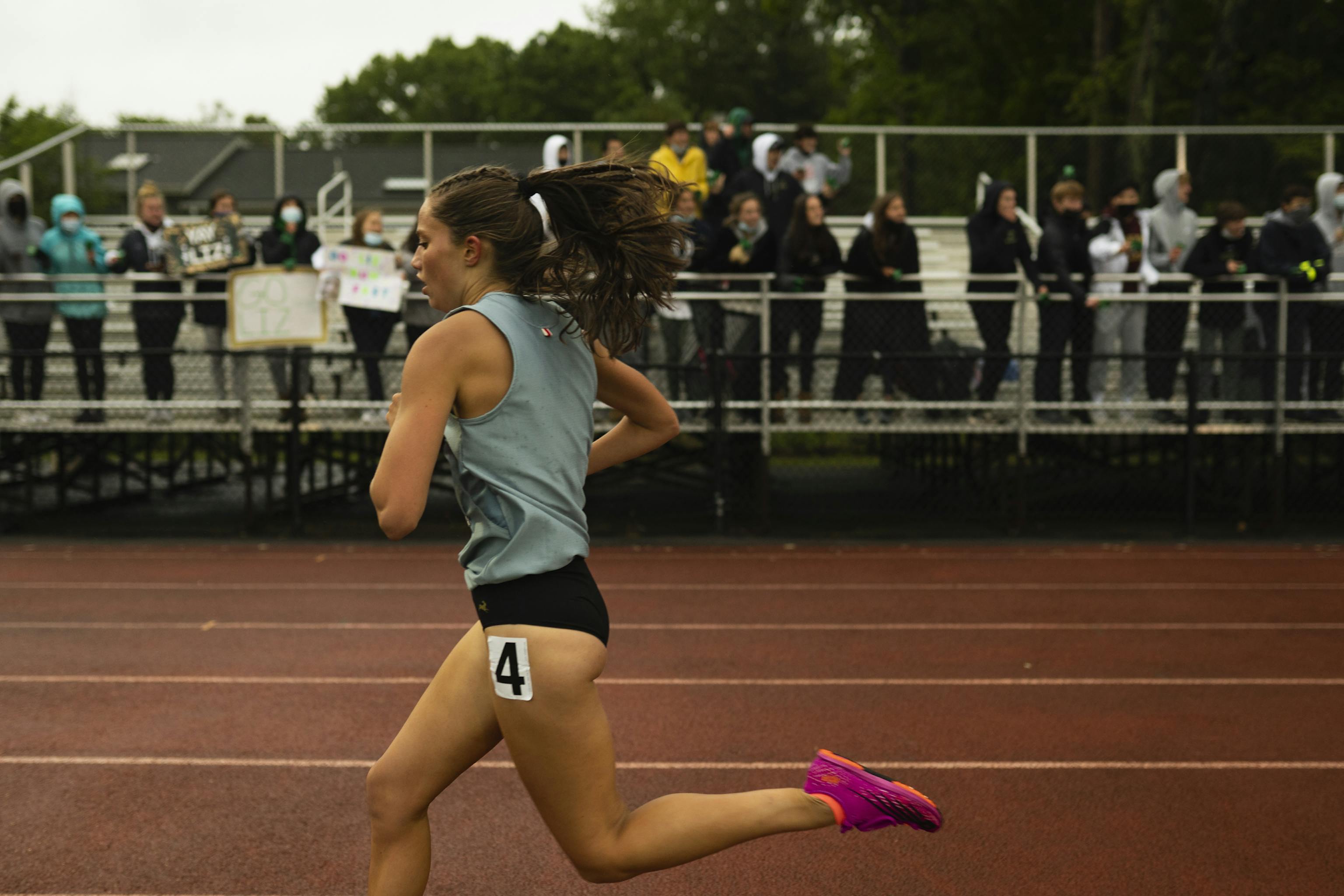

Under the Lights
Runners of all ages and abilities came together at the Platinum PT Qualifier twilight to pursue personal records and Olympic Trials standards.
Words by Sheridan Wilbur
Photography by Benjamin Weingart
There was something in the air. It was supposed to just be magic.
With only two weeks until the closure of the Trials qualifying window, no amount of inclement weather could dampen the athletes’ spirits or extinguish the do-or-die attitude that burned inside them. Runners of all ages and accomplishments gathered around a puddle-soaked track to embrace the night. No one at the Platinum PT Qualifier Twilight meet was afraid of the dark.
Every race held an aura of possibility. It might have been some runners’ last chance to tick a Trials standard, even with the classic New England weather. That’s just part of the fun, and although we love to hate the unpredictability of spring in the Northeast, we know it makes us stronger and a hell of a lot tougher.
A big part of the fun at Platinum PT Qualifier, like any all-comers meet, is not knowing who will show up to the line, and what kind of form they’re bringing to the race. Twilight meets create an enchanting yet low pressure alternative to Championship events, offering something to everyone - from the chance to run a qualifying time, to stay sharp, or to experiment with a new event, different pacing, or new competitors.
Hard to imagine the National track scene without them, but the first ever twilight meet was held at Northeastern University in 1988. Athletes needed another chance to run fast and with the right unfolding, hit the standard before the 1988 Olympic Trials. With the help of track fanatics Bill Clark, coach Bob Sevene, Steve Vaitones and with the cooperation of Northeastern coach Mark Lech and support of Nike Boston, these low pressure high performance meets began.
A historically unflashy event, Platinum Twilight’s meet directors invited world-class and up-and-coming talents to Bishop Feehan High School, 40 miles outside Boston. Around 5 p.m., Olympic Trials qualifiers like Elle Purrier, Molly Huddle and Ben True, Trials hopefuls, pacers, East Coast amateurs, post-collegiate athletes, high schoolers, coaches, fans and the press came together. Some sat calmly in the basketball court with headphones on, hiding from the rain. Others shivered with red hands, looking for waterproof gloves. Still or shaking, amateurs and elites united by a simple motivation under the hoops: stay here now to run fast later.
For those staying at home, Tracksmith offered a free live stream with race commentary from Carrie Tollefson, Mary Cain and Chris Chavez to connect fans remotely.

The Possibility to Race Tactically
When bad weather happens, there's less of a tendency to feel like the race time matters. Instead, you can focus on the fun (and skill) of competition. At 6 p.m., 21 brave runners faced howling wind to run two chilly laps. Julia Rizk, 2019 NCAA mile champion, defeated Purrier, the U.S. indoor mile and 2 mile record holder, in 2:02.98. The foul weather had taken the OTQ out of the question but it made for gritty racing.
In the second heat, Sophia Gorriaran, a high school junior, went out for the lead, going “as fast as I normally would.” The elements had not deterred the teenager’s determination to dominate. Gorriaran, who had already earned a Trials bid, beat a field full of pros in 2:04.78.
Drew Piazza looked at the brute weather for what it was: “It’s a good thing that the conditions weren't good,” he told his teammates. “Times don’t matter. See how you feel. We’re conditioned to think about times as the only way to think about validating success, you can't do that.” In terms of weather, the athletes were given a bad hand but they played the cards they were dealt. “If you’re at the Trials and you don't practice racing, you're not gonna make it. You have to play the race,” Piazza said. He placed fourth overall in the Men’s 800m: “When you welcome harsher conditions, you get stronger.”
Michelle Howell, who hit the Trials standard over a month ago, took the opportunity to test out tactical racing: “It’s a good simulation of being able to deal with these things and get it done. The weather was less than ideal but it was good practice, because you don’t know what it’s gonna be like at Trials” she said after placing third in Gorriaran’s heat. Her teammate Maddy Kopp, hasn’t hit the standard yet but placed sixth overall and carried a similar perspective, told us: “I’d rather have a bad race to race than no races.”
Amy Piccolo, a recent grad from UConn, placed fifth in her heat with a time of 2:15.21, walking away inspired by her speedy competitors, saying, “Any chance to race with the people you look up to is a great opportunity to learn and have a good time.”
Twenty minutes later, the gun went off for the Men’s 800. Rajay Hamilton secured the win in 1:48.48 but didn't sneak under the OTQ mark (an ambitious 1:46.25). Drew Piazza, who came in fourth in the race said that “It was tough to go out and slow down and kick. Especially being so cold, then stay and make a move.” Making for a close race, the winner to fifth place finished within a second. Piazza didn’t disclose how he earned a season’s best time and instead explained, “Tactically, I felt good.”
Johnny Gregorek came in second, adding another mark for the family name to Twilight record books. His father, John Gregorek, raced a Northeastern Twilight in 1993 and snagged a time of 13:27 to qualify for the World Championships in the 5,000m.

The Possibility to Level Up
Twilight meets have a compelling history but meet directors make room for fresh faces. People usually try to run fast here and there’s not necessarily a full field. Darius Kipyego, one of the best high school middle distance runners in the U.S., ran 1:50.71 alongside the pros. He describes the Platinum PT Qualifier as “an experience that you can’t really take away. The energy of being with the top guys is unbelievable.”
Kipyego, an Iowa State commit, eagerly picked up tips from seasoned athletes: “It’s amazing to be with them, seeing how they warm up and stretch, their routine, how they get to this next level.” Kipyego had a promising start to reach this next level, coming in sixth overall, even without the same experience as his competitors.
“It’s more nerve racking than intimidating. You don’t wanna look like a fool, being three seconds behind,” he said. The thing is, when he ran a few seconds behind the pros at a twilight meet last year, he hit a personal best of 1:49.46. “I don’t think there’s the same kind of competition anywhere else.”
Since twilight races happen at night, athletes have to deal with their thoughts and manage patience (a euphemism for anxiety) for nearly an entire day. Kipyego says, “I wake up in the morning and know I still have eight hours left. I’m just waiting for the time to come.” It’s hard to relax during the day when you have as much unbridled energy to race as he does. Then the time did come - Kipyego’s pre race jitters were calmed by the experts around him. He told us, “I just warmed up with Sam Ellison and Johnny Gregorek. When you’re out there, everyone is so friendly.”
Feeling nervous before a race is natural. It just means you care. Whether you’re an older athlete or a high schooler, everyone feels the stress of wanting to do your best. The Platinum PT Qualifier created an environment where experienced elites were passing their tips along to teens; such as how to turn worry into adrenaline. Kipyego explained, “You get these relationships when you come here.” Where else can a high schooler learn how to handle performance nerves from a pro during something as casual yet intimate as a warmup? Many high schoolers cheered sponsored athletes on the sidelines, as spectators, while Kipyego raced beside them.
Piazza, who has a few more years on Kipyego and finished two spots ahead, doesn’t think too much about the time leading up to the race. “I don’t worry about when I wake up. You can’t think so much or let stress cause you to do things or look things up. The best races are when you're not expecting anything. I didn’t think anything and that’s why it went so well. Minimal brain power.” (Piazza’s coach, Mark Coogan, actually ran in a Northeastern Twilight meet in 1989 as part of the ‘fourteen under fourteen’ in the 5,000m with a time of 13:38.54. I looked it up).
Threads of older generations to younger generations weave twilight meets from the past to the present. Piazza told METER, “I remember myself in high school and I didn’t have an opportunity to race in a meet with pros.” Now as a pro himself, he notices how high schoolers see what they do and “hopefully integrate it too.” He says, “Everyone interacts with each other. I talked to Kipyego for a bit. It’s cool to see younger kids and see them race.” There was a collective energy where everyone cares about the people as much as their own race, outshining any self-seeking competitiveness.

The Possibility for Good Vibes
Most of the athletes say twilight meets are just more fun. “They break up the monotony of doing the same thing every time you race. There’s a different vibe in the air,” Piazza said. “You can actually focus and get back within yourself. It’s more chill.” Howell and Kopp agree that the vibe was what got them excited for racing in the first place - what running for the love of it is about. Howell told us, “You feel faster. The energy is higher. And the schedule is faster paced.” Kopp added that, “Under the lights, it’s more intense and focused.”
Howell explained that the nighttime start times obscure a dimension of pressure though, “because you can decompress and do other things throughout the day or you can also think about it all day and be stressed out.” It depends on how you handle race day nerves. Kopp says, “It feels like you’re the big show, under these blaring lights and it’s dark out.” That sounds like a lot of pressure but she thinks, “There’s more pressure but in a good way.”
It sounds like everyone was using this meet to have a good time regardless of the time and to prepare for the next race. Piazza was planning to run another 800 the following weekend with less chill weather in Texas, in hopes of hitting the OTQ again (he already hit the standard in 2019). He says, “In warmer weather, hopefully I’ll have more to give and stay on pace and keep it hot.”
Kipyego was keeping his sights on the U20s in Chile and for another opportunity to hit the mark as his competitors raced in NCAAs. He had one more week to make it happen. “This was a season best so I can’t really complain, especially having a stress fracture in December. I’m feeling good. No matter what your time is, it’s about how you’re feeling and what you're looking like,” he said. At Twilight, athletes were tuning into themselves.

Other Platinum Highlights
Kaylie Armitage of La Salle Academy went out from the gun in the High School Girls Mile and stole the halftime show. Picking up on the behaviors of the elites around her, she said, “They’re not that nervous”. And when she got a challenge on the backstretch, Armitage held the field off to win. She matched her PR in 4:54.44.
Evan Reynolds of Bishop Hendricken went to snag first in the Boys Mile with a time of 4:16.19.
Josette Norris had secured the 1500 win in 4:06.30. Berkson, placing 7th in a time of 4:14.52 says she hadn’t been to many twilight meets but likes the spectrum of people that these meets include. “It’s more accessible than a typical elite meet,” she said. “It’s a community here with all classifications of runners. A lot of the high schoolers were out cheering.” She did her best to chase the OT standard and left with a PR; this was one of the best fields she had ever been in. “I love when it’s local. I hate flying anywhere.”
For Abbe Goldstein, the 1500 was about racing as hard as she could. A recent Harvard graduate, she had missed her entire senior year of NCAA competition due to campus policies. After fourteen months of no races, she competed every weekend since May 15 as an unattached athlete under “naive blind faith.” Goldstein said, “it’s crazy that I ran fast enough to think about the Trials because I didn’t have a chance to compete in the NCAA nationals. Looking at the starting list, half of these people were born in the 80s.” Twilight meets are a whole different world than the NCAA and she considers it a privilege to race against people she’s looked up to for so long. She said, “A 4:10 isn’t celebrated” (Goldstein has run as quick as 4:10.94). She placed 8th overall in a time of 4:20.74.
Ben Flanagan and Ben True both hit OTQ marks in the 5,000m running 13:20.67 and 13:22.38 respectively, both going under 13:25.00.
In the Men’s 1,500m, five men ran 3:40, and Eric Holt got the win in 3:40.05.
In the final event of the night, Emily Sisson dominated the field of 5,000 runners and hit 14:59.12, over 20 seconds below the OTQ and brought Amy Eloise Markovc and Erica Kemp under the Trials standard (15:20.00). Molly Huddle came in fourth, with a time of 15:24.12.